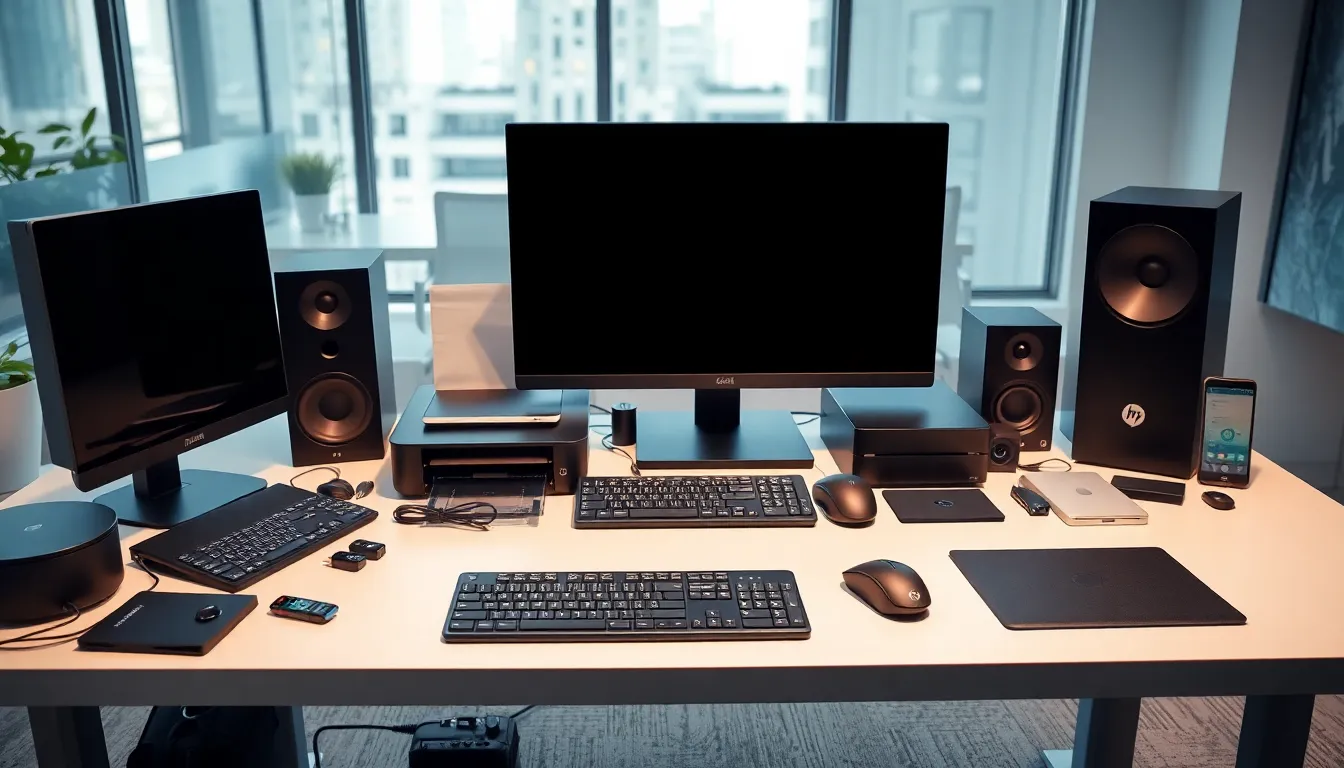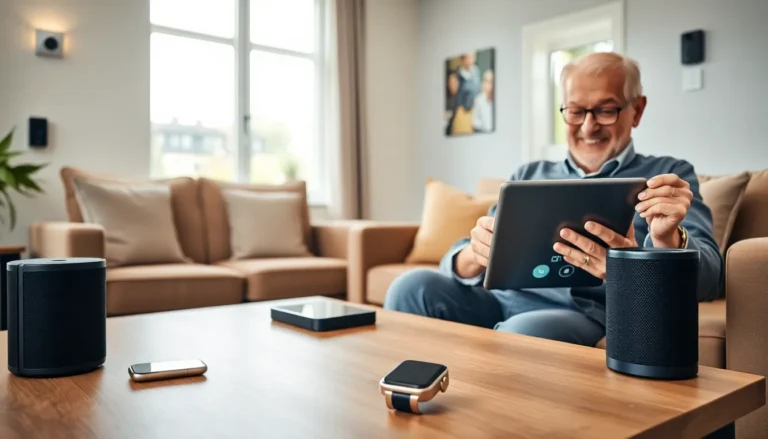In today’s tech-driven world, connecting hardware devices is more crucial than ever. Whether it’s linking printers to computers or integrating smart home gadgets, seamless connectivity enhances functionality and user experience. Understanding how to effectively connect these devices can save time and boost productivity.
With an ever-expanding array of options, from wired connections to wireless networks, navigating the landscape of hardware connectivity can be overwhelming. However, mastering these connections unlocks a world of possibilities, allowing users to harness the full potential of their devices. This article delves into the essentials of connecting hardware devices, offering practical tips and insights for both beginners and seasoned tech enthusiasts alike.
Table of Contents
ToggleOverview of Connecting Hardware Devices
Connecting hardware devices involves establishing a link between two or more pieces of equipment, allowing them to communicate and function together. This process can significantly improve productivity, expand capabilities, and enhance the overall user experience.
Wired Connections
Wired connections use physical cables to link devices. Common examples include USB cables for peripherals, HDMI cables for displays, and Ethernet cables for network connections.
Advantages:
- Stability: Wired connections provide consistent and reliable communication.
- Speed: Transmissions typically occur at higher speeds compared to wireless methods.
Wireless Connections
Wireless connections eliminate the need for physical cables, utilizing technologies like Wi-Fi, Bluetooth, and NFC.
Examples include:
- Wi-Fi: Connects devices to local networks for internet access.
- Bluetooth: Facilitates short-range communication between devices like headphones and smartphones.
Benefits:
- Mobility: Wireless devices can connect from various locations without being tethered.
- Convenience: Users can easily add or remove devices from the network.
Challenges in Connecting Devices
Connecting hardware can present challenges, such as compatibility issues, interference, and setup complexities.
Common obstacles include:
- Incompatibility: Devices require compatible ports and protocols for successful connections.
- Interference: Wireless signals can be disrupted by physical obstructions or other electronic devices.
Best Practices for Successful Connections
Implementing effective strategies is crucial for seamless connectivity.
Key practices:
- Identify Requirements: Understand the specific needs for each device to determine the best connection method.
- Use Quality Cables: Select high-quality cables to ensure optimal performance for wired connections.
- Keep Firmware Updated: Regularly updating device firmware enhances compatibility and security.
By following these guidelines, users can achieve successful hardware connections that enhance their technology experiences.
Types of Hardware Devices

Various hardware devices play critical roles in technology connections, categorized primarily as input devices, output devices, and storage devices. Understanding these categories aids in selecting the appropriate equipment for specific tasks.
Input Devices
Input devices facilitate user interaction with computers and other systems. Common input devices include:
- Keyboard: Enables text and command entry for software applications.
- Mouse: Provides point-and-click navigation on the screen.
- Scanner: Converts physical documents into digital format for processing.
- Microphone: Captures audio input for recording or communication.
These devices translate user actions into data that computers can process, significantly affecting user experience and efficiency.
Output Devices
Output devices convey information from a computer to users. Notable output devices encompass:
- Monitor: Displays visual content and user interfaces.
- Printer: Produces physical copies of digital documents and images.
- Speakers: Outputs audio, enhancing multimedia experiences.
- Projector: Projects visual content onto larger screens for presentations.
These devices enable users to perceive processed data in various formats, improving communication and engagement.
Storage Devices
Storage devices provide data retention and retrieval capabilities. Essential storage devices include:
- Hard Disk Drive (HDD): Offers substantial storage for files and applications.
- Solid State Drive (SSD): Delivers faster data access and improved performance.
- USB Flash Drive: Serves as portable storage for quick file transfer.
- Cloud Storage: Enables remote access to data over the internet for enhanced flexibility.
These devices ensure data availability and security, crucial for both personal and professional use.
Connection Methods
Connecting hardware devices can occur through wired or wireless methods, each with unique advantages and limitations.
Wired Connections
Wired connections depend on physical cables to link devices. Common types include:
- USB (Universal Serial Bus): Used for connecting various devices like keyboards, mice, and storage devices, USB offers reliable data transfer rates and power delivery.
- HDMI (High-Definition Multimedia Interface): Primarily for transmitting high-definition audio and video between devices such as TVs and computers, HDMI provides a stable connection ideal for multimedia applications.
- Ethernet: Used extensively for networking, Ethernet connects computers to local area networks (LAN), enabling stable and fast internet access.
Wired options deliver advantages in stability, speed, and security. However, cable clutter and limited mobility may pose challenges.
Wireless Connections
Wireless connections utilize radio waves or infrared signals to connect devices without physical cables. Key technologies include:
- Wi-Fi: Ideal for home and office environments, Wi-Fi enables devices to connect to the internet or each other over a network, offering convenience and flexibility.
- Bluetooth: Commonly used for connecting peripherals like headsets, speakers, and keyboards wirelessly, Bluetooth provides lower power consumption and ease of use.
While wireless connections facilitate mobility and reduce clutter, they may be susceptible to interference and limited range. Users must ensure device compatibility and security settings for optimal performance.
Challenges in Connecting Hardware Devices
Connecting hardware devices often presents several challenges. Users frequently encounter compatibility issues and troubleshooting connection problems that can hinder effective use.
Compatibility Issues
Compatibility issues arise when devices use different standards or technologies. Devices from various manufacturers may not support shared protocols or interfaces, leading to connection failures. For instance, using an HDMI-to-VGA adapter with a device that only supports HDMI input creates a barrier. Additionally, outdated drivers can cause malfunctions, as they may not be optimized for newer hardware. Ensuring that devices support common standards like USB-C or Bluetooth 5.0 can mitigate these issues.
Troubleshooting Connection Problems
Troubleshooting connection problems often involves identifying and resolving multiple factors. Users can benefit from these key steps:
- Check cables: Inspect both wired and wireless cables for damage or loose connections.
- Restart devices: Power cycling devices can resolve temporary glitches that disrupt connectivity.
- Update drivers: Keeping drivers up to date ensures devices function correctly and utilize the latest features.
- Examine settings: Verify network settings and security parameters to ensure proper configurations are in place.
- Test compatibility: Use tested combinations of devices to determine whether compatibility issues exist.
These methods help users systematically address connectivity problems, leading to a smoother experience when connecting hardware devices.
Future Trends in Hardware Connectivity
Future trends in hardware connectivity focus on enhancing both speed and versatility in device interaction. Several key areas show significant promise for advancing how devices connect.
Increased Adoption of USB-C
Increased adoption of USB-C technology provides a universal solution for connecting a range of devices. USB-C offers faster data transfer rates and greater power delivery capabilities, making it easier for users to connect high-performance peripherals without multiple adapters.
Expansion of Wireless Technologies
Expansion of wireless technologies, such as Wi-Fi 6 and 5G, improves connectivity. Wi-Fi 6 enhances speed and efficiency in crowded areas, facilitating seamless data transmission for smart devices. 5G technology offers low latency and high bandwidth, enabling rapid connections between devices in various applications, from IoT to remote work.
Integration of Cloud Connectivity
Integration of cloud connectivity allows devices to communicate and share data effortlessly. Cloud-based solutions facilitate remote access and storage, offering users flexibility and convenience. With advancements in security protocols, users can trust cloud connections for both personal and professional applications.
Emergence of Smart Home Devices
Emergence of smart home devices continues to reshape how users connect and manage hardware. Innovative products use centralized hubs to streamline connections and control across multiple devices, such as lights, thermostats, and security systems. This trend highlights the importance of interoperability among devices for improved user experiences.
Development of AI-Powered Connectivity Solutions
Development of AI-powered connectivity solutions leverages machine learning to optimize device interactions. These solutions can automatically detect and troubleshoot connectivity issues, improving user satisfaction. Enhancements in user support will make managing connected hardware less cumbersome, addressing existing challenges.
Adoption of Standardized Protocols
Adoption of standardized protocols ensures compatibility across various devices. Initiatives like Matter aim to create an ecosystem where devices from different manufacturers work together seamlessly. These standardized approaches reduce barriers to entry for new devices and enhance the overall user experience.
These trends collectively signify a robust future for hardware connectivity, emphasizing ease of use, efficiency, and security.
Successfully connecting hardware devices is essential for maximizing productivity and enhancing user experiences. By understanding the strengths and weaknesses of both wired and wireless connections, users can make informed decisions tailored to their specific needs. Embracing best practices and staying updated on technological advancements will ensure smoother connectivity and compatibility across devices.
As the landscape of hardware connectivity evolves, keeping an eye on emerging trends will help users adapt to new technologies and maintain efficient workflows. The future promises exciting developments that will continue to reshape how devices interact, making it easier for everyone to stay connected in an increasingly digital world.





